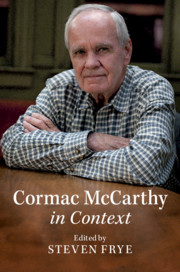Book contents
- Cormac McCarthy in Context
- Cormac McCarthy in Context
- Copyright page
- Contents
- Contributors
- Acknowledgments
- Chronology
- Part I Environments
- Part II Literary Contexts: Sources, Influences, Allusions
- Chapter 5 William Faulkner
- Chapter 6 Ernest Hemingway
- Chapter 7 Herman Melville and the American Romance Tradition
- Chapter 8 Romanticism
- Chapter 9 Naturalism
- Chapter 10 The Bible
- Chapter 11 Allusion and Allegory
- Part III Intellectual Contexts
- Part IV Social and Cultural Contexts
- Part V Archives, Critical History, Translation
- Works Cited
- Index
Chapter 7 - Herman Melville and the American Romance Tradition
from Part II - Literary Contexts: Sources, Influences, Allusions
Published online by Cambridge University Press: 12 December 2019
- Cormac McCarthy in Context
- Cormac McCarthy in Context
- Copyright page
- Contents
- Contributors
- Acknowledgments
- Chronology
- Part I Environments
- Part II Literary Contexts: Sources, Influences, Allusions
- Chapter 5 William Faulkner
- Chapter 6 Ernest Hemingway
- Chapter 7 Herman Melville and the American Romance Tradition
- Chapter 8 Romanticism
- Chapter 9 Naturalism
- Chapter 10 The Bible
- Chapter 11 Allusion and Allegory
- Part III Intellectual Contexts
- Part IV Social and Cultural Contexts
- Part V Archives, Critical History, Translation
- Works Cited
- Index
Summary
Romanticism and realism are not diametrically opposed, and the history of the terms “romance” and “novel” reveal dialogical genre processes. Optative romanticism in Europe and America is in tension with negative romanticism. The principal American romance tradition is largely one of a dark romanticism, in which the gothic and grotesque merge with realism in the “romance-novel,” as in the fictions of Edgar Allan Poe, Nathaniel Hawthorne, Herman Melville, and later modernist and postmodernist writers. Four basic modes of Gothic can be identified ontologically as: indeterminate “historical” Gothic; determinate “rationalized” Gothic; determinate “supernatural” Gothic; indeterminate “equivocal” Gothic. The ambiguous fourth mode may involve questions of metaphysics, epistemological uncertainty, psychological instability, and textual indeterminacy. The fourth mode characterizes the fictions of Cormac McCarthy and Herman Melville – strikingly exemplified by the pervasive theme of “inscrutability” in Moby-Dick, McCarthy’s favorite book.
Keywords
- Type
- Chapter
- Information
- Cormac McCarthy in Context , pp. 68 - 78Publisher: Cambridge University PressPrint publication year: 2020

